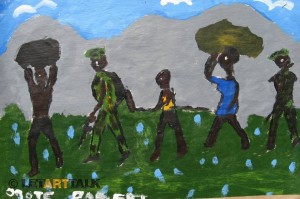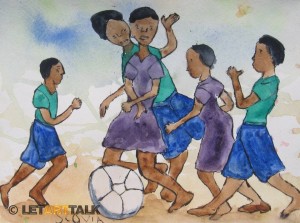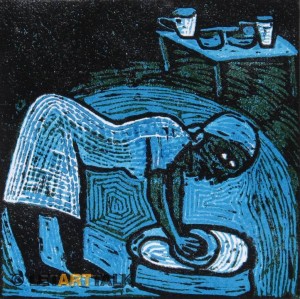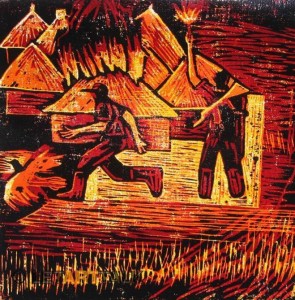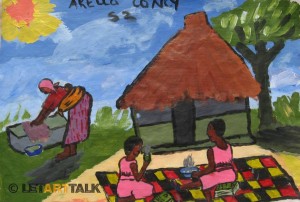unfortunately I can’t seem to get Java to embed this video in html so here’s the link: (to skip the ad there will be a button at the top left of the screen)
This video essentially is an documentary footage/interview between VBS TV and reporter Ben Anderson of the BBC which outlines the findings from a longer BBC documentary Ben Anderson had been working on. The point of the BBC documentary was to uncover the living conditions of Bangladesh workers who have been living in the United Arab Emirates (UAE). At the start of the video Anderson tells how Bangladeshi workers are offered by local hiring agents a chance to make 300 pounds a month while working in the UAE. This amount of money drives many of them to pay an illegal 2000 pound “booking fee” in order to enter the country and work for one of the local construction companies. Upon arriving in Dubai, workers’ passports are taken away from them and are told that they will be working long hours for around half the promised amount. Many workers at this point are forced to work for the large corporations to try to pay off their massive debt and have no money to send back to their families. Within Dubai as well as within mainstream public opinion, workers are paid much more than they would normally receive at home and gladly work in Dubai, however this is a fabrication for these workers have been forced into indebted (bonded) labour. They cannot leave because they do not have their passports or any money to travel back to Bangladesh and live in misery with no avenue to change their situation. Anderson shows footage of the cramped, squalid, and un-hygenic living conditions these men are forced to endure along with the systematic censorship by companies of this reality. Government is also picked out as being aware of the issues and illegal practices facing these men but only resort to fining the companies. These conditions are never seen by tourists, much less media, and few have spoken out about these horrendous conditions which these Bangladeshi men endure. To make matters worse for these workers, the financial crisis has allowed for companies to illegally not pay their workers and threaten to fire them if they do not work harder. It is shown that some individuals feel an utter sense of loss and hopelessness and do not have any mechanisms in which to struggle against their conditions.
The reason why I picked this video is because it was able to explain the underlying conditions faced by these Bangladeshi workers living around Dubai more concisely than the several other documentaries produced on the subject. Unfortunately the video does not have many interviews with the men in the camps themselves but I believe their general sentiments surrounding the conditions exposed in longer documentaries, and the few short personal interviews available, were relayed effectively by the interviewee. Overall, there is no real way for these workers to have a voice and any interviews were limited clips in the videos I found during my search (none were made by the men themselves, possibly out of fear or lack of resources). I think the issue is important enough to post even with the lack of direct involvement in an attempt to shed light on their situation.
To build on this lack of voice, It is important to note that it is illegal for workers to found or join unions that further silences any attempt by them to improve their living/working conditions. Lacking their passports, the threat of being fired or sent home exacerbates this silence for if they are fired they must work illegally at even lower wages which is risky to do in the UAE. It is also important to note that both the state and the companies are compliant in sustaining these situations of bonded labour. These workers are often described as “illegal workers” (due to their lack of passports) by mainstream media and several demonstrations by workers have received minimal and largely negative coverage.
To expand on the development impact, The flow of capital into Dubai has made the city one of the major centres of development (and overdevelopment) worldwide and with it has come the demand for labour. Much like the situation during the plantation era in the Americas, capitalists have sought out cheap sources of labour in which to build up new economies. In the case of the Americas this came in the form of bonded labour followed quickly by slavery. In the case of Dubai, bonded labour from South Asia has been the solution to Dubai’s labour shortage at the expense of their basic human rights. These workers have been absolutely marginalized within UAE society and have been branded “others” by the native population even though they make up to 85% of the population by some estimates. UAE citizens, although also Muslim, have widely promoted ethnic differences to distinguish, marginalize and ignore the plight of these foreign workers. Development has not occurred evenly within Dubai though, and as the video has shown, the workers have been forced to live in underdeveloped conditions which lack the basic necessities of proper housing, waste management and cooking facilities. In fact, many of the contractors involved are able to increase this uneven development, not only through the redistribution of capital into Dubai’s infrastructure and their pockets, but by removing capital from Bangladeshi families who often have to sell their homes in order to pay the initial 2000 pounds.
As a final note, Ben Anderson mentions the group called Mafiwasti which is the only organization solely dedicated to improving these workers’ conditions for they still have no personal avenue to voice their struggles. Videos can be found on their website here but still seem to focus on interviews with government officials for answers rather than giving a personal voice to the workers. http://www.mafiwasta.com/links.htm






